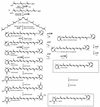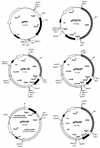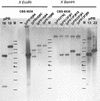Metabolic engineering of the carotenoid biosynthetic pathway in the yeast Xanthophyllomyces dendrorhous (Phaffia rhodozyma)
- PMID: 12839738
- PMCID: PMC165150
- DOI: 10.1128/AEM.69.7.3728-3738.2003
Metabolic engineering of the carotenoid biosynthetic pathway in the yeast Xanthophyllomyces dendrorhous (Phaffia rhodozyma)
Abstract
The crtYB locus was used as an integrative platform for the construction of specific carotenoid biosynthetic mutants in the astaxanthin-producing yeast Xanthophyllomyces dendrorhous. The crtYB gene of X. dendrorhous, encoding a chimeric carotenoid biosynthetic enzyme, could be inactivated by both single and double crossover events, resulting in non-carotenoid-producing transformants. In addition, the crtYB gene, linked to either its homologous or a glyceraldehyde-3-phosphate dehydrogenase promoter, was overexpressed in the wild type and a beta-carotene-accumulating mutant of X. dendrorhous. In several transformants containing multiple copies of the crtYB gene, the total carotenoid content was higher than in the control strain. This increase was mainly due to an increase of the beta-carotene and echinone content, whereas the total content of astaxanthin was unaffected or even lower. Overexpression of the phytoene synthase-encoding gene (crtI) had a large impact on the ratio between mono- and bicyclic carotenoids. Furthermore, we showed that in metabolic engineered X. dendrorhous strains, the competition between the enzymes phytoene desaturase and lycopene cyclase for lycopene governs the metabolic flux either via beta-carotene to astaxanthin or via 3,4-didehydrolycopene to 3-hydroxy-3'-4'-didehydro-beta-psi-caroten-4-one (HDCO). The monocylic carotenoid torulene and HDCO, normally produced as minority carotenoids, were the main carotenoids produced in these strains.
Figures





Similar articles
-
Metabolic engineering of the astaxanthin-biosynthetic pathway of Xanthophyllomyces dendrorhous.FEMS Yeast Res. 2003 Dec;4(3):221-31. doi: 10.1016/S1567-1356(03)00158-2. FEMS Yeast Res. 2003. PMID: 14654426 Review.
-
Isolation and functional characterisation of a novel type of carotenoid biosynthetic gene from Xanthophyllomyces dendrorhous.Mol Gen Genet. 1999 Oct;262(3):453-61. doi: 10.1007/s004380051105. Mol Gen Genet. 1999. PMID: 10589832
-
Cloning and characterization of the astaxanthin biosynthetic gene encoding phytoene desaturase of Xanthophyllomyces dendrorhous.Biotechnol Bioeng. 1999 Jun 20;63(6):750-5. doi: 10.1002/(sici)1097-0290(19990620)63:6<750::aid-bit13>3.0.co;2-7. Biotechnol Bioeng. 1999. PMID: 10397832
-
Alternative splicing of transcripts from crtI and crtYB genes of Xanthophyllomyces dendrorhous.Appl Environ Microbiol. 2003 Aug;69(8):4676-82. doi: 10.1128/AEM.69.8.4676-4682.2003. Appl Environ Microbiol. 2003. PMID: 12902257 Free PMC article.
-
Phaffia rhodozyma: colorful odyssey.Int Microbiol. 2003 Sep;6(3):169-74. doi: 10.1007/s10123-003-0130-3. Epub 2003 Jul 30. Int Microbiol. 2003. PMID: 12898396 Review.
Cited by
-
Engineering the oleaginous red yeast Rhodotorula glutinis for simultaneous β-carotene and cellulase production.Sci Rep. 2018 Jul 18;8(1):10850. doi: 10.1038/s41598-018-29194-z. Sci Rep. 2018. PMID: 30022171 Free PMC article.
-
Optimization of microbial cell factories for astaxanthin production: Biosynthesis and regulations, engineering strategies and fermentation optimization strategies.Synth Syst Biotechnol. 2022 Feb 18;7(2):689-704. doi: 10.1016/j.synbio.2022.01.002. eCollection 2022 Jun. Synth Syst Biotechnol. 2022. PMID: 35261927 Free PMC article. Review.
-
Microbial astaxanthin biosynthesis: recent achievements, challenges, and commercialization outlook.Appl Microbiol Biotechnol. 2020 Jul;104(13):5725-5737. doi: 10.1007/s00253-020-10648-2. Epub 2020 May 13. Appl Microbiol Biotechnol. 2020. PMID: 32399589 Review.
-
Expression of Xanthophyllomyces dendrorhous cytochrome-P450 hydroxylase and reductase in Mucor circinelloides.World J Microbiol Biotechnol. 2015 Feb;31(2):321-36. doi: 10.1007/s11274-014-1784-z. Epub 2014 Dec 11. World J Microbiol Biotechnol. 2015. PMID: 25504221
-
Metabolic engineering and cultivation strategies for efficient production of fucoxanthin and related carotenoids.Appl Microbiol Biotechnol. 2025 Mar 4;109(1):57. doi: 10.1007/s00253-025-13441-1. Appl Microbiol Biotechnol. 2025. PMID: 40035874 Free PMC article. Review.
References
-
- Albrecht, M., N. Misawa, and G. Sandmann. 1999. Metabolic engineering of the terpenoid biosynthetic pathway of Escherichia coli for the production of the carotenoids β-carotene and zeaxanthin. Biotechnol. Lett. 21:791-795.
-
- An, G.-H., J. Bielich, R. Auerbach, and E. A. Johnson. 1991. Isolation and characterization of carotenoid hyperproducing mutants of yeast by flow cytometry and cell sorting. Bio/Technology 9:70-73. - PubMed
-
- An, G.-H., M.-H. Cho, and E. A. Johnson. 1999. Monocyclic carotenoid biosynthetic pathway in the yeast Phaffia rhodozyma (Xanthophyllomyces dendrorhous). J. Biosci. Bioeng. 88:189-193. - PubMed
-
- An, G.-H., C.-H. Kim, E.-S. Choi, and S.-K. Rhee. 1996. Medium optimization for cultivation of carotenoid hyperproducing Phaffia rhodozyma mutant HT-5FO1C. J. Ferment. Bioeng. 82:515-518.
-
- Andrewes, A. G., H. J. Phaff, and M. P. Starr. 1976. Carotenoids of Phaffia rhodozyma, a red-pigmented fermenting yeast. Phytochemistry 15:1003-1007.
Publication types
MeSH terms
Substances
LinkOut - more resources
Full Text Sources
Other Literature Sources
Research Materials

